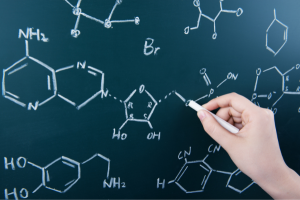Isomerism is an important topic in organic chemistry. Isomers are chemical compounds with the same molecular formula but different structural formulas. The number of possible isomers is so great that it requires noting structural or semi-structural formulas of organic compounds. The structure of individual isomers affects their properties, e.g. boiling point or solubility.

The most common isomerism in organic chemistry is called constitutional isomerism. It includes compounds that differ from each other by the location of the bonds in the chain or ring and the arrangement of functional groups in the backbone.
This type of isomerism is typical mainly for aliphatic hydrocarbons. Chain isomerism involves a change in the length of the carbon chain as well as in the number of substituents. It is typical for alkanes. For this reason, in organic chemistry there are straight chain and branched chain molecules. As the chain length increases, i.e. the number of carbon atoms in the structure increases, the number of chain isomers for a given compound also increases. Propane has two isomers and heptane has nine. The number of isomers for a given molecule changes irregularly and it is not possible to derive a specific formula for this correlation.
Chain isomerism is important when it comes to the properties of organic compounds. Among other things, different boiling points for isomers were observed (branched isomers are more volatile) or a change in the intensity of Van der Waals interactions (linear molecules adhere much more closely to each other and therefore short-range interactions are stronger).
The substituent or functional group can be located at different sites in the molecule, that is, it can be attached to different carbon atoms in the chain of an organic compound. When giving the name of a compound, it is necessary to indicate the position of a given substituent by mentioning the number of the carbon atom to which it has been attached.
A similar situation occurs in the case of compounds containing multiple bonds, i.e. double bonds (e.g. alkenes) or triple bonds (e.g. alkynes). The isomerism of a multiple bond in organic compounds means that such bond can occur between different carbon atoms in the chain. When naming such isomers, it is necessary to indicate the number of the carbon atom at which the multiple bond occurs.
This type of isomerism applies to compounds with the same molecular formula but forming different functional groups. It is mainly observed in ketones, aldehydes, esters of saturated carboxylic acids and saturated aliphatic carboxylic acids. For example, functional group-based isomers are propane-2-one (ketone) and propanal (aldehyde).

Stereoisomers are isomers that differ from each other in the spatial arrangement of atoms.
This type of isomerism is typical for unsaturated organic compounds with a double bond, e.g. alkenes. Cis-trans isomerism means a different arrangement of substituents relative to the double bond or ring plane in ring compounds. It is typical for molecules in which there is no possibility of rotation around this bond (“rigid” element of the compound). In addition, there must be two non-identical groups on each carbon atom forming a double bond. If a molecule has four different substituents, cis-trans isomerism cannot be determined. To indicate the type of isomerism present in a molecule, the prefixes cis- or trans- are placed before the chemical name of the compound. Cis-isomers are characterized by identical substituents around the unsaturated bond or ring lying on the same side. The opposite is true for the trans-isomers, where the substituents are arranged on opposite sides. This type of isomerism also occurs in the case of cycloalkanes, i.e. compounds built of a saturated hydrocarbon chain forming a ring.
Cis-trans isomers for a given compound usually differ in physical and chemical properties. This is due to different distances between the atoms. Substituents in the cis-position are much closer together than in the trans-position.
The chirality of molecules is one of the most important concepts in organic chemistry. Chiral carbon atoms are those that are attached to four different substituents. If a given chemical compound has one chiral atom, then it forms two pairs of molecules, so-called enantiomers. They look like mirror images of each other, but they are not overlapping. This is caused by a tetrahedral distribution of bonds around the chiral atom.
A characteristic feature of enantiomers is their ability to rotate the plane of polarized light. If one of them turns its plane by a strictly defined angle to the left, the other one turns it to the right, also by the same angle value. A racemic mixture contains equal amounts of both enantiomers and therefore does not have the ability of optical rotation. The phenomenon of polarized light rotation is used in polarimetry. It enables the measurement of the concentration of an optically active substance in the sample, based on the size of the rotation angle of the plane of polarized light.
Diastereoisomers are molecules that belong to the group of steric isomers but are not enantiomers to each other. In other words, they are stereoisomers that are not enantiomers. Usually, these are compounds that contain more than one asymmetric carbon atom. Individual diastereoisomers of a given molecule of an organic compound differ in their physical and chemical properties due to the presence of different interatomic distances.
Find your place at the PCC Group. Learn about our offer and keep developing with us.
Unpaid summer internships for students and graduates of all courses.